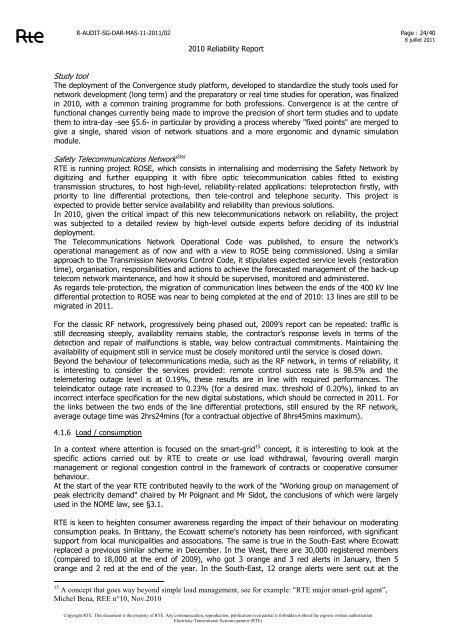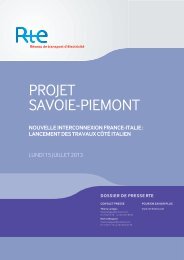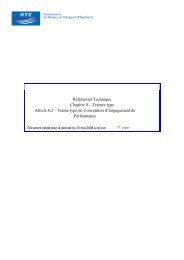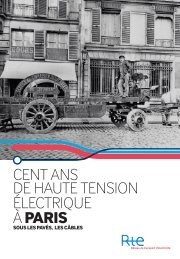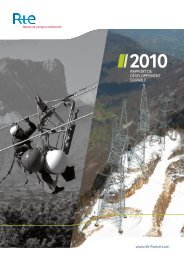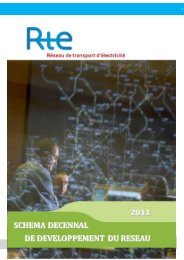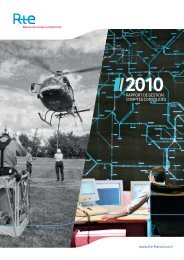Power System Reliability Report - RTE
Power System Reliability Report - RTE
Power System Reliability Report - RTE
- No tags were found...
Create successful ePaper yourself
Turn your PDF publications into a flip-book with our unique Google optimized e-Paper software.
R-AUDIT-SG-DAR-MAS-11-2011/022010 <strong>Reliability</strong> <strong>Report</strong>Page : 24/408 juillet 2011Study toolThe deployment of the Convergence study platform, developed to standardize the study tools used fornetwork development (long term) and the preparatory or real time studies for operation, was finalizedin 2010, with a common training programme for both professions. Convergence is at the centre offunctional changes currently being made to improve the precision of short term studies and to updatethem to intra-day -see §5.6- in particular by providing a process whereby "fixed points" are merged togive a single, shared vision of network situations and a more ergonomic and dynamic simulationmodule.Safety Telecommunications Network Glos<strong>RTE</strong> is running project ROSE, which consists in internalising and modernising the Safety Network bydigitizing and further equipping it with fibre optic telecommunication cables fitted to existingtransmission structures, to host high-level, reliability-related applications: teleprotection firstly, withpriority to line differential protections, then tele-control and telephone security. This project isexpected to provide better service availability and reliability than previous solutions.In 2010, given the critical impact of this new telecommunications network on reliability, the projectwas subjected to a detailed review by high-level outside experts before deciding of its industrialdeployment.The Telecommunications Network Operational Code was published, to ensure the network‟soperational management as of now and with a view to ROSE being commissioned. Using a similarapproach to the Transmission Networks Control Code, it stipulates expected service levels (restorationtime), organisation, responsibilities and actions to achieve the forecasted management of the back-uptelecom network maintenance, and how it should be supervised, monitored and administered.As regards tele-protection, the migration of communication lines between the ends of the 400 kV linedifferential protection to ROSE was near to being completed at the end of 2010: 13 lines are still to bemigrated in 2011.For the classic RF network, progressively being phased out, 2009‟s report can be repeated: traffic isstill decreasing steeply, availability remains stable, the contractor‟s response levels in terms of thedetection and repair of malfunctions is stable, way below contractual commitments. Maintaining theavailability of equipment still in service must be closely monitored until the service is closed down.Beyond the behaviour of telecommunications media, such as the RF network, in terms of reliability, itis interesting to consider the services provided: remote control success rate is 98.5% and thetelemetering outage level is at 0.19%, these results are in line with required performances. Theteleindicator outage rate increased to 0.23% (for a desired max. threshold of 0.20%), linked to anincorrect interface specification for the new digital substations, which should be corrected in 2011. Forthe links between the two ends of the line differential protections, still ensured by the RF network,average outage time was 2hrs24mins (for a contractual objective of 8hrs45mins maximum).4.1.6 Load / consumptionIn a context where attention is focused on the smart-grid 15 concept, it is interesting to look at thespecific actions carried out by <strong>RTE</strong> to create or use load withdrawal, favouring overall marginmanagement or regional congestion control in the framework of contracts or cooperative consumerbehaviour.At the start of the year <strong>RTE</strong> contributed heavily to the work of the "Working group on management ofpeak electricity demand" chaired by Mr Poignant and Mr Sidot, the conclusions of which were largelyused in the NOME law, see §3.1.<strong>RTE</strong> is keen to heighten consumer awareness regarding the impact of their behaviour on moderatingconsumption peaks. In Brittany, the Ecowatt scheme‟s notoriety has been reinforced, with significantsupport from local municipalities and associations. The same is true in the South-East where Ecowattreplaced a previous similar scheme in December. In the West, there are 30,000 registered members(compared to 18,000 at the end of 2009), who got 3 orange and 3 red alerts in January, then 5orange and 2 red at the end of the year. In the South-East, 12 orange alerts were sent out at the15 A concept that goes way beyond simple load management, see for example: "<strong>RTE</strong> major smart-grid agent”,Michel Bena, REE n°10, Nov.2010Copyright <strong>RTE</strong>. This document is the property of <strong>RTE</strong>. Any communication, reproduction, publication even partial is forbidden without the express written authorisationElectricity Transmission <strong>System</strong> operator (<strong>RTE</strong>)


